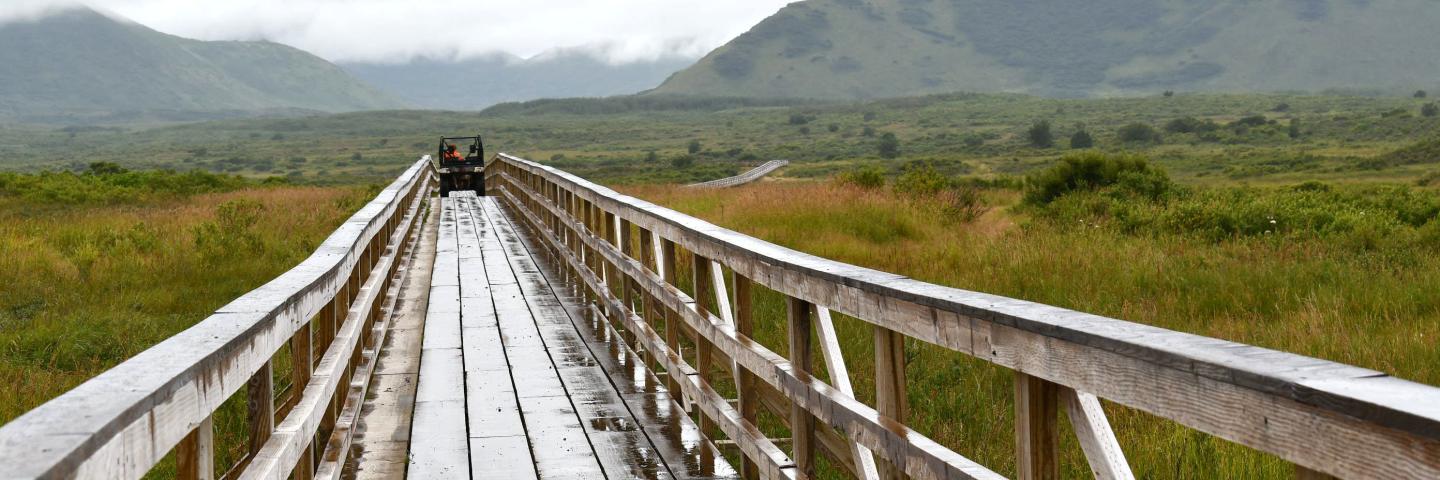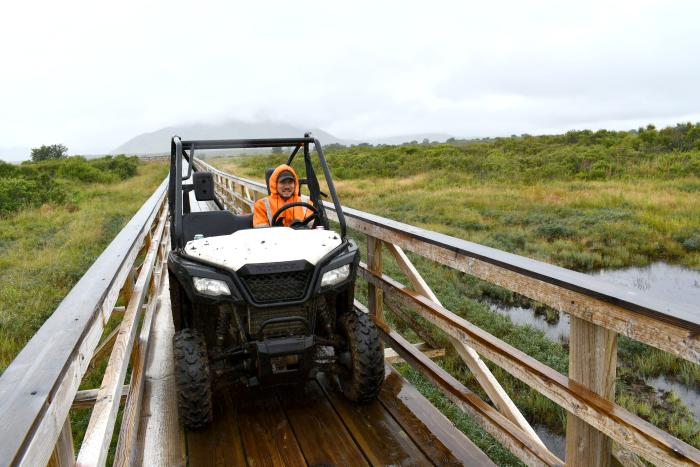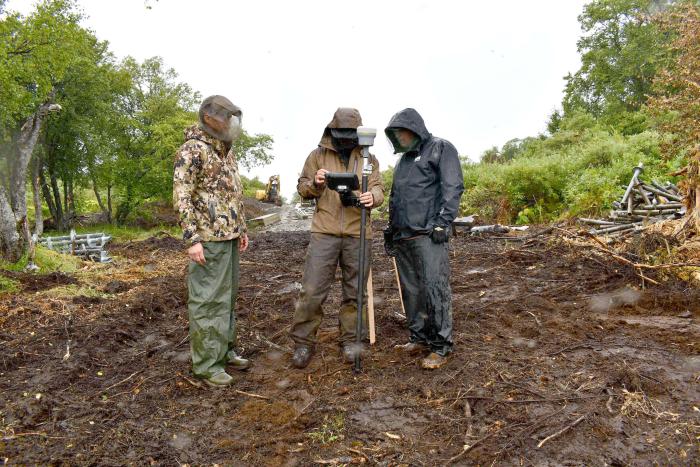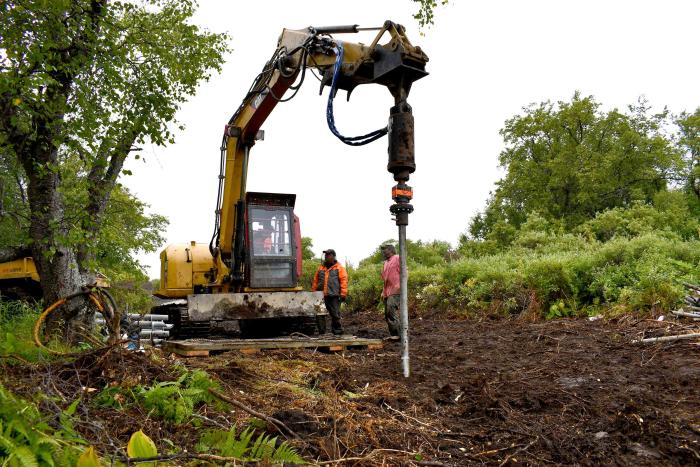Larsen Bay Trail Preserves Access to Subsistence Areas

Koniag and NRCS are working together to reduce soil erosion and improve access to historical fishing sites on Kodiak Island.
View Story Map Version of this Article (ArcGIS)
Maintaining safe access to hunting, fishing and gathering areas is a critical need for communities in rural Alaska who depend on subsistence for their livelihood. Wild game like moose, bear and caribou, and aquatic species like salmon are key staples to fill the freezer so that residents have enough food to last through the long winter.
On Kodiak Island in the remote community of Larsen Bay, local residents have traversed a path from the head of Larsen Bay to the Karluk River for generations. The path is a gateway for them to access historical and cultural sites for hunting, fishing, gathering and other subsistence uses.
The path was used long before the passage of the Alaska Native Claims Settlement Act (ANSCA) in 1971, which formed the 12 Regional Corporations and 200+ village corporations that currently own and manage Alaska Native private lands throughout the state.
Larsen Bay is on Kodiak Island, Alaska and is only accessible by plane or boat. The trek to the Larsen Bay Trail requires multiple modes of transportation: A small plane ride from Kodiak to Larsen Bay, followed by a boat ride to the head of the bay, and a ride in a construction vehicle up to the start of the mud pile boardwalk section of trail.
Over the years, continued use of the path caused heavy soil erosion and severe degradation of the soil, water and vegetation. The wet, rainy climate on Kodiak Island combined with repeated all-terrain vehicle (ATV) use rendered some spots unpassable. Some stretches of mud were so deep that stepping on it could easily sink a person down to their thighs.
Private landowners with Koniag, the ANSCA Regional Corporation in the area, sought a solution to protect the soil while also preserving access to this important subsistence area. They reached out to the USDA Natural Resources Conservation Service (NRCS) for help.
"Before NRCS, there were challenges on these trails and very few opportunities to address them," said Peter Olsen, natural resources manager for Koniag. "The ability to participate with NRCS in their programs is changing the landscape here, and that wouldn't have happened without someone stepping up and investing big time."

NRCS visited the site and recommended installing the “Trails and Walkways” conservation practice to reduce soil erosion and improve human access.
Trails and Walkways facilitate the movement of people, animals or ATVs while protecting the soils from erosion and protecting ecologically sensitive sites.
The original design used a heavy-duty geometric plastic material called geoblock to cover the trail. While the geoblock material was relatively inexpensive and easy to install, after a year or two of use it was rendered ineffective. A different solution was needed.
NRCS engineers designed 1.6 miles of trail using two construction methods: 1) helical pile boardwalk and 2) mud sill boardwalk. They surveyed the land and assessed the soil stability along the path. Areas deemed unstable required a helical pile boardwalk, a structure supported by thick posts drilled deep into the ground to a prescribed level of torque. The posts are evenly spaced every 8 feet and the precise post locations are mapped using GPS satellite technology. Once the helical posts are installed, treated lumber is then affixed to the posts along with side rails for human safety.
“The helical pile boardwalk is a sturdy, dependable option, though the material and installation costs are higher,” said Craig.
Due to changing terrain and soil conditions, another trail design called a mud sill boardwalk was used on the stretches of trail with stable soils. This design places wood planks directly on the ground after the area is prepped, similar to the way a roadbed is prepped before paving. The mud sill boardwalk doesn’t require any drilling of material into the ground and is a lower cost alternative to helical pile boardwalk. When possible, trails are rerouted to reduce costs and damage to resources.
Koniag completed phase 1 of the trail in 2021 with helical pile boardwalk. Phase 2 was completed in 2022 using a mix of helical pile and mud sill.
"We're very happy with the trail. I've got calls from shareholders and I've had nothing but positive feedback from the community," Peter said. "People said they took Grandma up there for the first time in years, because she could finally access it again. That's huge for our community."
"The whole community benefits, Native people and the public, as it's a long-standing public lands easement and the Karluk River is a high priority access area in Kodiak," Peter said.

Koniag In-House Labor Crew and Equipment
The labor crews and heavy use equipment are owned and maintained in-house by Koniag. This technical capacity allows Koniag to implement their NRCS contracts efficiently and effectively, and it makes them more successful in applying for and securing additional funds for other trail projects in their region. Their in-house crew employs tribal members and shareholders as well, which keeps economic benefits within the community.
“Koniag's experience in managing and implementing trail projects makes things run smoothly,” Craig said. “They have been an excellent landowner to work with.”
"Labor is a problem everywhere right now," Peter said. "We're in the long game. We are making the investment in equipment and training our labor force. My son Aaron is leading the labor crew. We have opportunities for our young people to be employed. If I don't get our own people engaged in natural resources management, it's going to leave with me. I'm determined to do something about that."
"Our people are marine people. They understand fishing," Peter added. "But if people can see a career opportunity, they get pretty excited. Almost nobody comes to us with the qualifications, but we train them and Koniag is willing to invest in them."
The total NRCS investment in the project is about $4 million, which comes from federal Farm Bill funding through the Environmental Quality Incentives Program (EQIP).
Koniag is exploring options to do a third phase that would extend the trail all the way to the beach, where boat traffic accesses Larsen Bay. However, the terrain on this remaining stretch of trail is steep and presents some engineering challenges. But if it’s like most other things in Alaska, where there’s a will, there is a way.

Story and Photos by Tracy Robillard, NRCS Alaska Public Affairs Specialist.

